2024 Hyundai Kona Review and Test Drive
The all-new, roomier compact SUV blends high style and advanced tech with solid value.
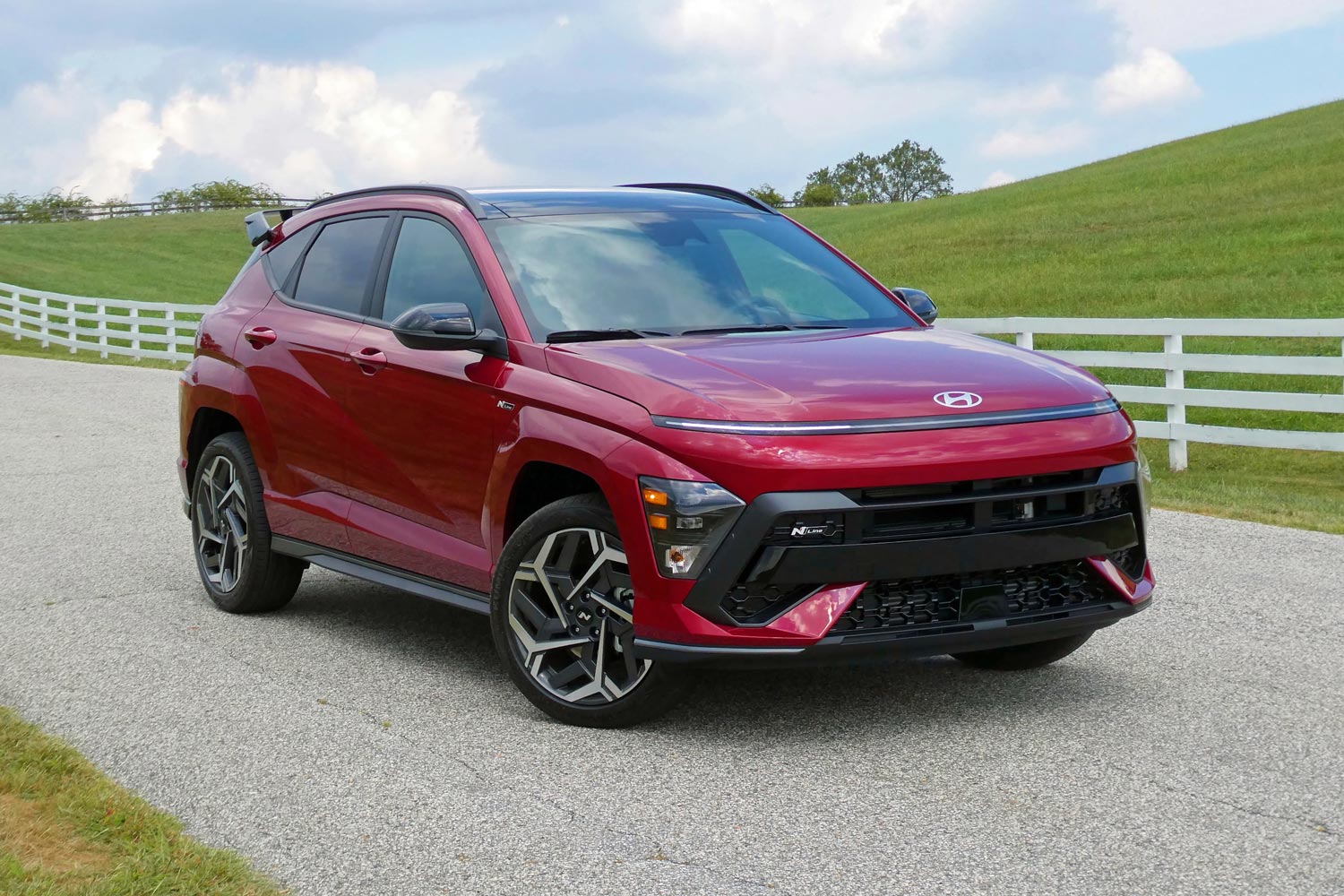 Ron Sessions
Ron Sessions
Article QuickTakes:
Look around a bit, and you might notice that small crossover SUVs are well-represented on U.S. roads. Nearly every mainstream brand has one in its lineup, and some automakers offer several. They're appealing to buyers attracted to the slightly elevated driving position, available all-wheel drive (AWD), and easy cargo flexibility small and compact SUVs offer compared to entry-level cars.
The Hyundai Kona arrived for the 2018 model year, bringing significant styling pizazz to that formula. Unfortunately, the first-generation Kona was smaller inside than many rivals, a problem Hyundai hopes to rectify with the all-new second-generation 2024 Kona.
Nearly 6 inches longer, 2.6 inches taller, and an inch wider than the original Kona, the redesigned 2024 Hyundai Kona offers more room for people and cargo. In addition, the size increase puts it smack dab in the thick of the small crossover SUV segment, making it more competitive against rivals such as the Chevrolet Trailblazer, Honda CR-V, Subaru Crosstrek, Toyota Corolla Cross, and Volkswagen Taos.
At first, the 2024 Kona will come in SE, SEL, N Line, and Limited trim levels. Base prices range from the mid-$20,000s to the mid-$30,000s, including the destination charge to ship the SUV from the Ulsan, South Korea, factory that builds it to your local dealership. A battery-electric version of the Kona will follow in early 2024, with prices available closer to its on-sale date.
 Ron Sessions
Ron Sessions
Gas engines power all but the upcoming Kona Electric. The Kona SE and SEL models get a 2.0-liter four-cylinder engine making 147 horsepower, and the Kona N Line and Limited use a 190-hp 1.6-liter turbocharged four-cylinder. Front-wheel drive is standard, with all-wheel drive available for an additional $1,500. The 2024 Kona Electric will not be available with AWD.
For this Kona review, I test-drove an N Line in Baltimore, Maryland, and the surrounding rural areas north of the city. It came with AWD and optional carpeted floor mats, bringing the manufacturer's suggested retail price to $33,695, including the $1,335 destination charge. Hyundai provided the vehicle for this Kona review and paid for airfare, lodging, and meals during the evaluation period.
 Ron Sessions
Ron Sessions
2024 Hyundai Kona: The Design
When penning the 2024 Kona, Hyundai designers created the electric version first and then crafted the look of the gas-powered models. As a result, all Konas have signature wrap-around horizon-line LED bars that grace the nose and tail of the small SUV. The designers also made the first-generation Kona's prominent wheel arches even bigger and bolder, incorporating the headlamps and taillamps.
The wheel-arch cladding cradling the pushed-to-the-corners 17-, 18-, or 19-inch alloy wheels is black on SE, SEL, and Limited trims. The N Line employs body-color overfenders, which gives that model a sleeker and much sportier look. The N Line also adds a more aggressive-looking front lower fascia, a roof-mounted rear spoiler, and dual exhaust tips. Put it all together, and even though the Kona N Line doesn't include any special go-fast hardware, it has more of a hot-hatch look.
Open a front door and the N Line's technology array is impressive. Dual 12.3-inch landscape-format color displays, one for the digital instrumentation and one for the infotainment system, live under a single panel that subtly arcs toward the driver.
There are a lot of hard buttons on the dashboard, but for me, that means less time spent with my eyes off the road diving through screen menus. The switchgear is logically arranged and has an excellent tactile response to inputs. The N Line and Limited use a steering-column-mounted electronic joystick transmission shifter that frees up storage space in the center console.
Offering all-day driving comfort, the N Line's heated front seats feature eight-way power adjustment for the driver and a manual height adjuster for the front passenger. The N Line expresses its sporty persona with leather and grippy Alcantara faux suede upholstery. It's the only Kona model available with genuine leather.
Other cabin accents exclusive to the N Line include red striping on the dashboard, red accent stitching on the seats, metal-finished foot pedals, a black headliner, and a leather-wrapped sport steering wheel with thumb grips and paddle shifters.
Speaking of comfort, the N Line has a set-and-forget dual-zone automatic climate-control system that kept the cabin cool in stifling 98-degree heat and legendary Chesapeake Bay humidity. For 2024, Hyundai added heating and cooling vents to the rear of the Kona's front console to give rear-seat passengers some relief as well.
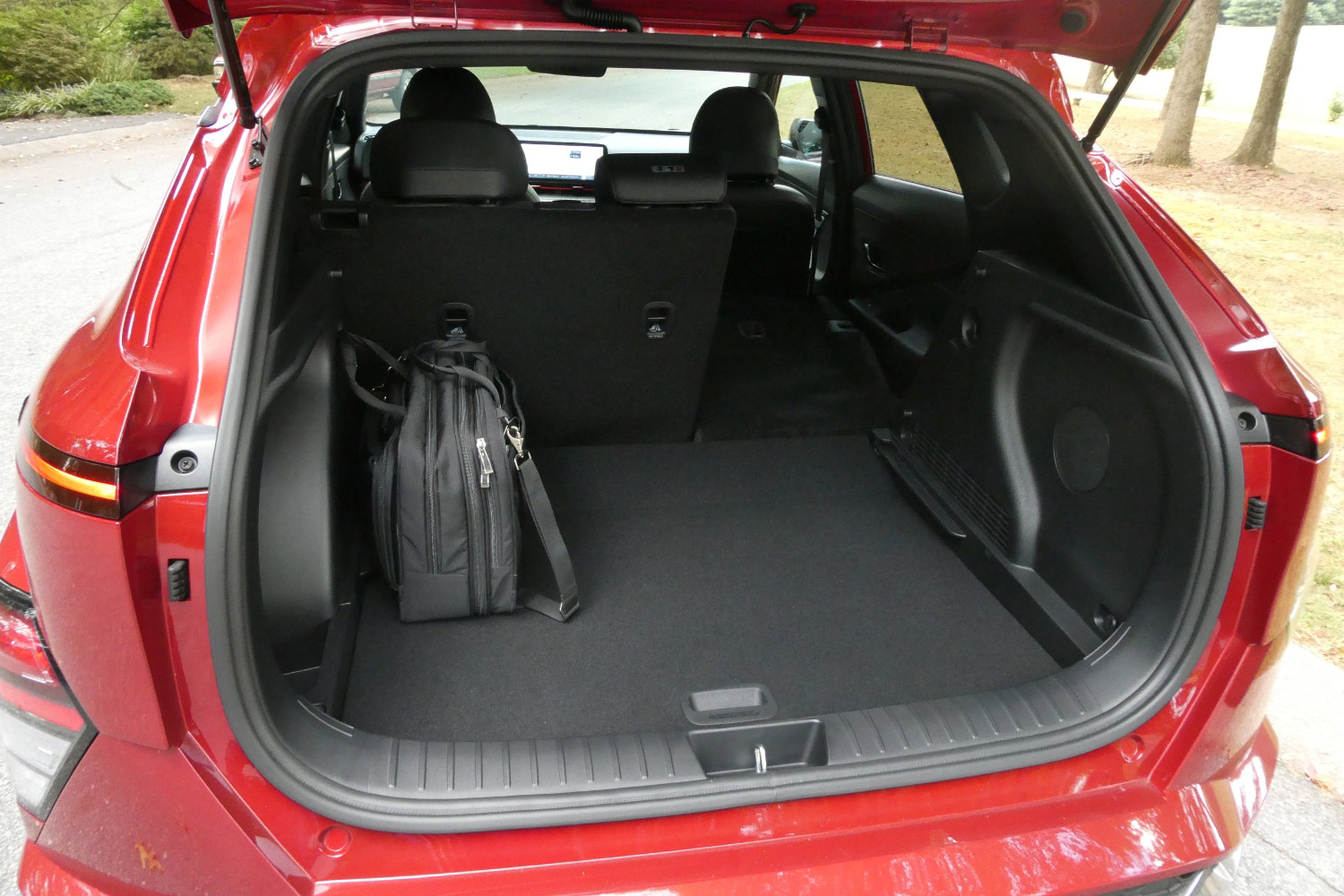 Ron Sessions
Ron Sessions
When Hyundai stretched the Kona by nearly 6 inches for 2024, it allocated the extra space evenly between the passenger cabin and cargo area. The 2024 Kona has 3 more inches of rear legroom than the previous version, enabling me to slide my 6-foot, 2-inch frame into the back seat without moving the front seat up a few notches.
Although lower trims such as the SE and SEL still use a cable-operated transmission shifter on the center console, the N Line upgrades to a steering-column-mounted shift-by-wire system that frees up lots of console space for storage. The N Line's console incorporates a large open tray, retractable half-ring cupholders, and a wireless smartphone charger. There's even a stand to place a smartphone in a vertical position.
The 2024 Kona has more cargo space, too. Compared with the first-generation model, the area behind the rear seat increases by 6.3 cubic-feet to 25.5 cu-ft. With the 60/40 split-folding back seat folded flat, cargo volume jumps by 17.9 cu-ft to 63.7 cu-ft.
Hyundai also improves access to the cargo area thanks to a wider liftgate opening. Beneath the adjustable cargo floor, there's some hidden storage space adjacent to the spare tire well, which is great for hiding a purse, camera bag, tablet, or other valuables. You can detach the cargo area security cover and stow it vertically in a slot behind the rear seat to carry bulkier cargo.
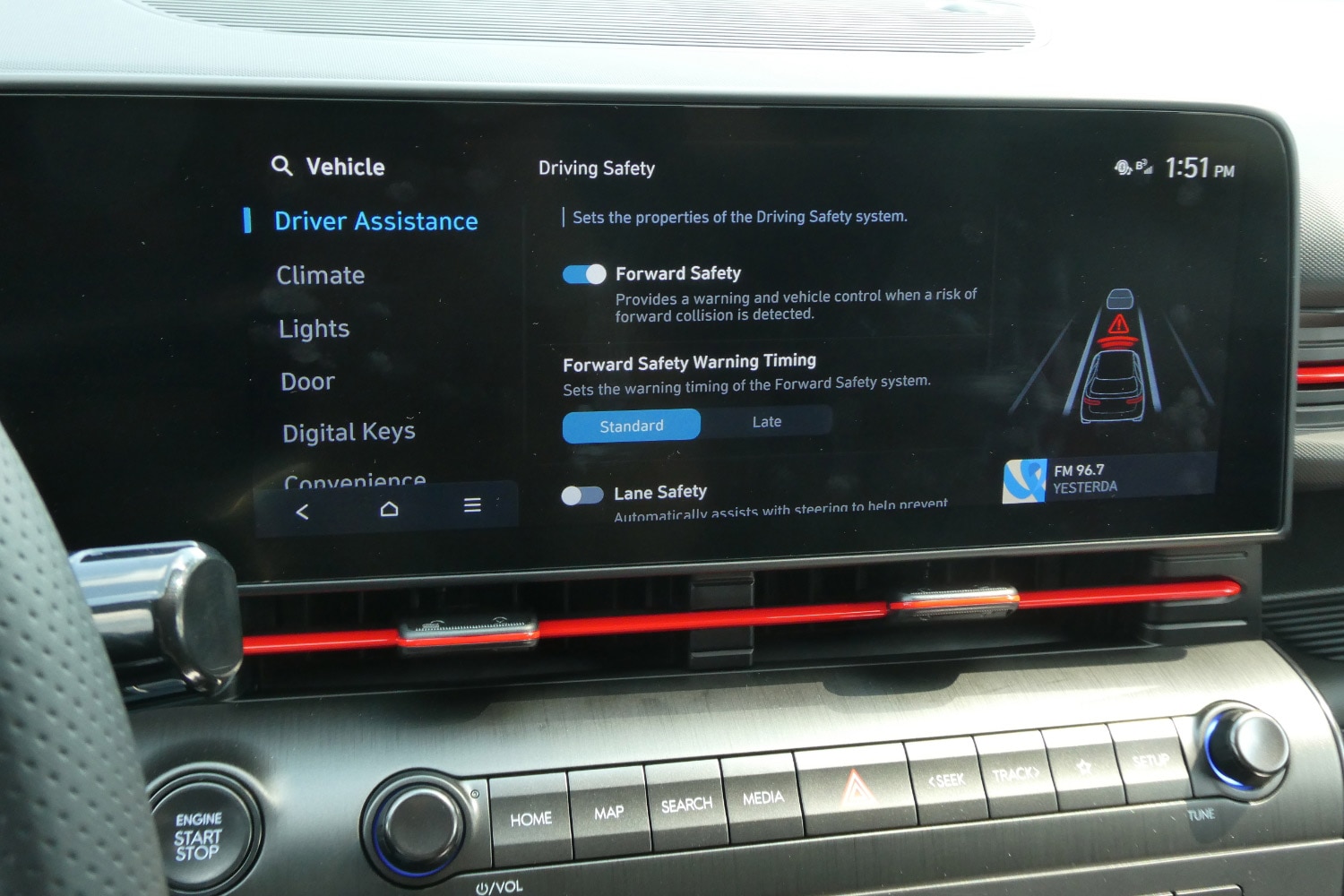 Ron Sessions
Ron Sessions
2024 Hyundai Kona: The Technology
For 2024, Hyundai upgrades the Kona to a standard 12.3-inch touchscreen infotainment system. Last year, the largest available system had a 10.25-inch display.
Apple CarPlay and Android Auto connectivity is standard, but you must use a cable to operate them. Hyundai says a future over-the-air update will add wireless smartphone connectivity. In addition, the infotainment system includes a three-month trial subscription to SiriusXM satellite radio, Bluelink connected services, access to a Wi-Fi hotspot, and a voice-recognition system. With N Line trim, a navigation system and a new, rich-sounding Bose eight-speaker premium audio system are also standard.
The Kona N Line's 12.3-inch infotainment touchscreen is among the largest in the small SUV segment and features readable type and easy-to-see icons. The system retains volume and tuning knobs and shortcut buttons beneath the screen for Home, Map, Search, Media, Favorites, and Setup.
Pairing my Samsung phone to the Kona's Bluetooth was quick and seamless. Once I fished out the proper USB cable from the glovebox, launching Android Auto and streaming music from my Pandora account proved easy.
Exploring unknown side roads for photo locations took me far off the prescribed course. As an electrical storm blew in with surprising speed, I tapped the dynamic voice-recognition button on the steering wheel to request real-time weather and traffic updates for the return trip to the hotel. I also needed directions but didn't know the hotel's address. Nevertheless, asking for the best route back to the hotel in plain English got me there quickly, safely, and mostly dry.
Hyundai has offered its Bluelink connected services at no charge for the first three years of ownership. When many other car companies charge extra monthly or annual fees for these services, Hyundai is expanding its Bluelink plans and making them complimentary to original owners for the duration they own their vehicles.
Now called Bluelink+, Hyundai's connected services come in Basic and Advanced plans. The Bluelink+ Basic plan includes maintenance reminders, remote diagnoses, and automatic collision notifications and is free for all first and subsequent owners for the duration of the vehicle's life.
The Bluelink+ Advanced plan covers everything else, including remote vehicle access, parental controls for teen drivers, and over-the-air map updates. Bluelink+ Advanced is also free to all first owners of a vehicle for the duration of their ownership period. People buying a used Hyundai get three months to a year of complimentary Bluelink+ Advanced, after which the subscription incurs a monthly charge.
The 2024 Kona features an impressive list of standard Hyundai SmartSense advanced driver-assistance systems. In addition to the features you now expect to find in a modern vehicle, my N Line test vehicle had an intersection-assist system that can detect oncoming traffic and attempt to prevent an unsafe turn.
In addition, the N Line has Highway Driving Assist, a semi-autonomous driving-assistance system combining adaptive cruise control with lane-centering assist. It is hands-on technology, meaning you must hold the steering wheel for it to work. It also uses navigation and highway data to slow the Kona for curves and can adjust vehicle speed according to roadside signage.
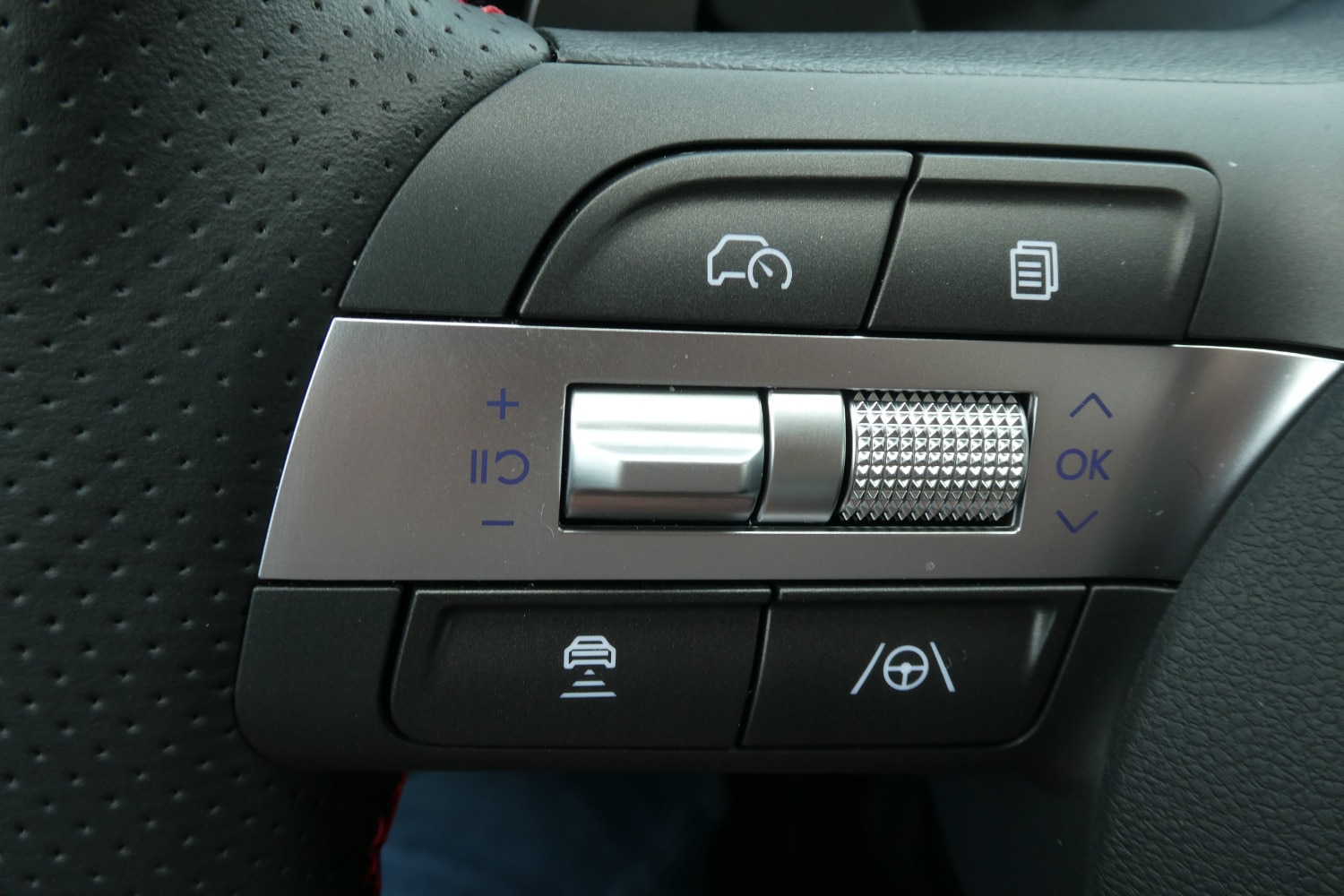 Ron Sessions
Ron Sessions
The Kona's safety features worked pretty much as advertised. The new haptic steering-wheel vibration associated with the lane-departure warning system gave my hands a good massage on the winding rural back roads north of Baltimore because it was difficult to avoid crossing over the curbside white lane markings on tight turns. Also, the driver-attention warning kept beeping and flashing messages to pay attention as my eyes wandered a bit, looking for interesting photo spots along the way.
One feature available in the range-topping Kona Limited but missing in the N Line is a surround-view camera that provides an overhead view of the SUV and its surroundings. With the Kona's jutting rear-seat headrests, sloping roofline, and steeply angled rear roof pillars and liftgate window, seeing what's behind the SUV can be challenging.
As of publication, neither the National Highway Traffic Safety Administration (NHTSA) nor the Insurance Institute for Highway Safety (IIHS) has posted crash-test ratings for the 2024 Hyundai Kona. Check the
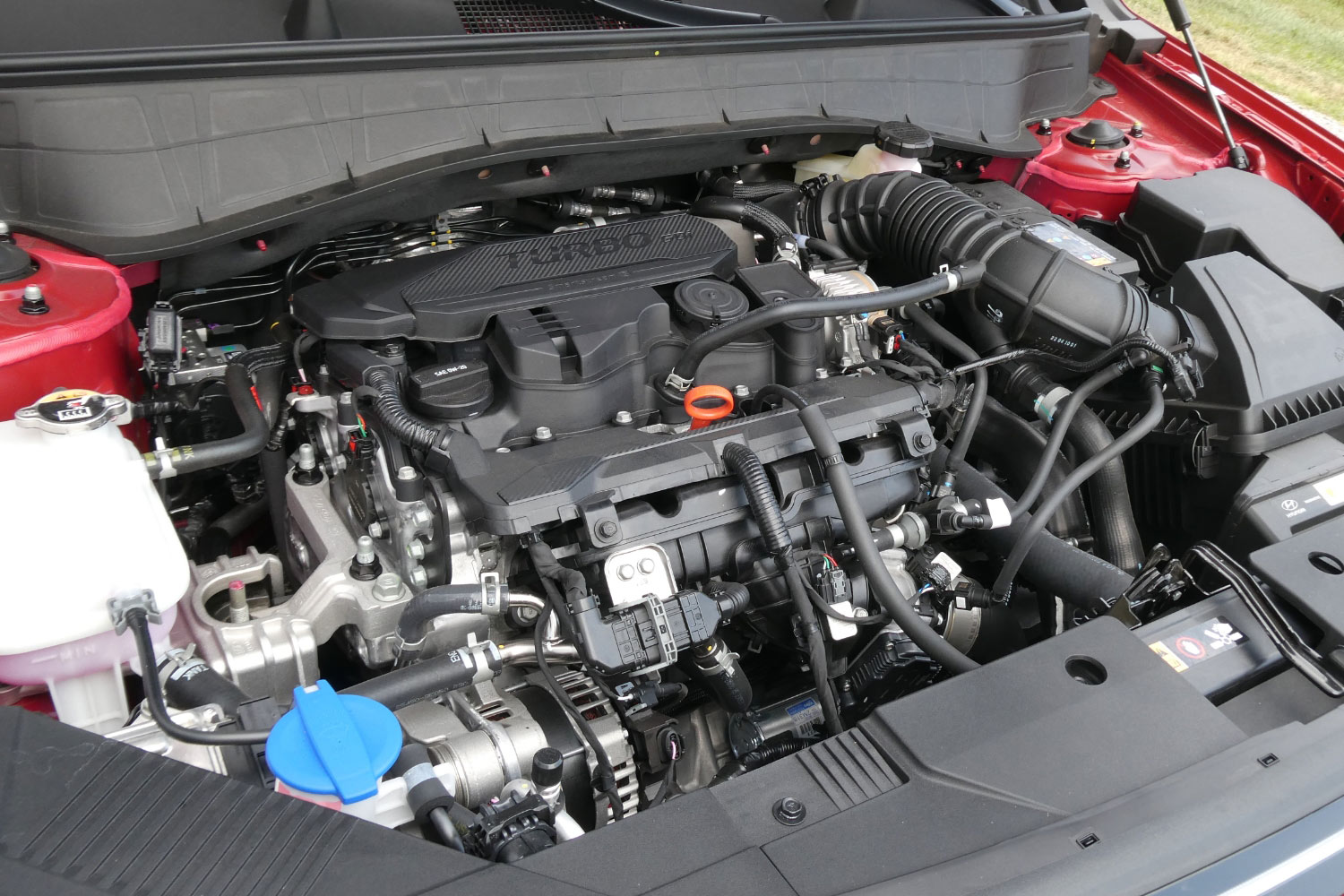 Ron Sessions
Ron Sessions
2024 Hyundai Kona: The Drive
With its sleek, EV-inspired nose and tail, bulging overfenders cradling generously sized 19-inch wheels pushed to the corners, wing-type rear spoiler, and dual-outlet exhausts, the 2024 Hyundai Kona N Line looks fast just standing still. But a replacement for the previous-generation Kona N it is not.
Fortunately, the Kona N Line has enough power to keep things interesting. It has a turbocharged 1.6-liter four-cylinder engine producing 190 horsepower and 195 pound-feet of torque, paired with a new eight-speed automatic transmission that provides smoother shifts than last year's seven-speed dual-clutch automatic. Front-wheel drive is standard, with all-wheel drive optional.
 Ron Sessions
Ron Sessions
The engine's torque is available between 1,700 and 4,500 rpm, resulting in responsive acceleration, effortless highway merging, and easy overtaking of slower traffic. Still, by my stopwatch the N Line took about 7.5 seconds to reach 60 mph from rest, keeping the Kona well out of hot-hatch territory.
According to the Environmental Protection Agency, the fuel-economy estimate for the Kona N Line is 28 mpg with FWD and 26 mpg with AWD. My N Line AWD test vehicle averaged 27 mpg over 70 miles of mixed driving. On one 30-mile stretch of Interstate, the test vehicle achieved an indicated 32.9 mpg.
Hyundai's AWD system varies power distribution between the front and rear wheels based on accelerator inputs, steering angle, and wheel-speed sensors. In addition, Normal, Eco, Sport, Snow, and AWD Lock driving modes govern its operation. Though the driving route didn't include any off-roading opportunities, a sudden thunderstorm made sections of the road slick. With the Kona in Normal mode during the deluge, which allows up to 35% of the power to flow to the rear wheels, the N Line's meaty 235/45R-19 all-season tires had no problems with grip.
 Ron Sessions
Ron Sessions
The Kona AWD models also feature an independent multilink rear suspension, replacing the simpler torsion beam rear suspension bolted into the front-drive models. My test vehicle had the more sophisticated underpinnings, and they provided a compliant but controlled ride on highways and well-paved back roads while delivering decent isolation on century-old cobblestone streets in the historic section of Baltimore.
In addition, the Kona's quick-ratio electric steering proved responsive in the turns while providing a stable and relaxed demeanor on highways. Another pleasant surprise was the Kona's firm brake-pedal feel and easily modulated four-wheel-disc brakes. Combined with the turbocharged engine and new eight-speed automatic transmission, these factors make this tidy-sized crossover enjoyable to drive.
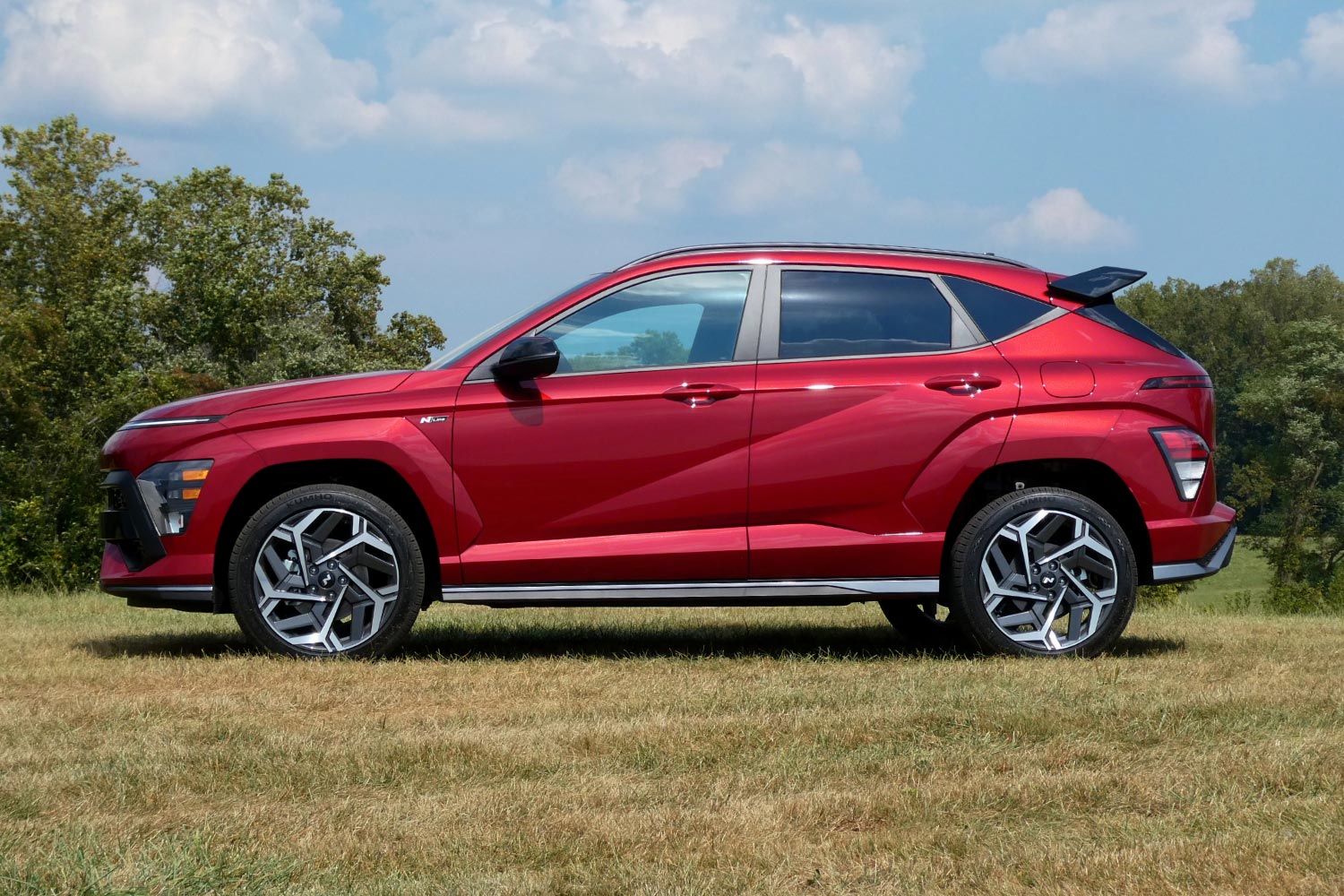 Ron Sessions
Ron Sessions
Is the 2024 Hyundai Kona a Good SUV?
The all-new 2024 Hyundai Kona is a good choice for people shopping for a small crossover SUV. The snappy design has lots of curb appeal and its new, roomier cabin and larger cargo hold offer everyday usefulness.
Hyundai has also addressed the concern about widespread theft of certain Hyundais and Kias, made possible because the vehicles were missing an engine immobilizer. The new Kona comes standard with one.
The 2024 Kona also includes an impressive number of standard comfort and convenience features for the price. Its infotainment, connectivity, safety, and advanced driving-assistance technologies are among the best in the segment. And in N Line and Limited trim, the turbocharged powertrain makes driving the Kona rewarding.
When you add lifetime access to Bluelink+ services and the Kona's generous warranty plan, Hyundai bakes even more value into its redesigned small SUV.



